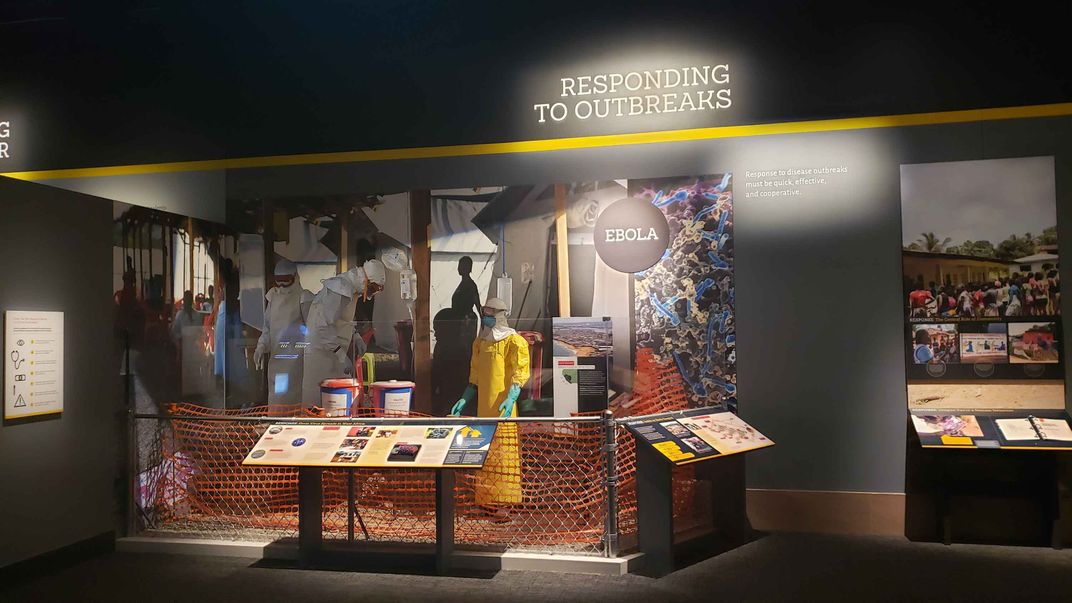How Museums Can Help the Public Make Sense of Pandemics
We can’t let fear overrun science, says Sabrina Sholts, the Smithsonian’s curator of biological anthropology
/https://tf-cmsv2-smithsonianmag-media.s3.amazonaws.com/filer/04/a9/04a925ea-d70c-4165-ac87-1d724269cf5b/outbreak_pandemics.jpg)
The novel coronavirus is sounding alarms everywhere. Quarantines, travel bans and flight suspensions have blocked transportation and tourism on an industrial scale. Shutdowns on the mass production and shipment of goods across China have put the “world’s factory” on hold. Supply chain disruptions and uncertainties have rattled financial markets internationally. Cancellations of mass assemblies have extended to school activities, trade events and religious gatherings thousands of miles apart. Some communities are resisting the presence of quarantine centers based solely on fear that it might bring this dark figure to their doorstep. Yet the CDC this week warned that Americans should expect and plan for community spread of the coronavirus in the United States.
Among all the frightening elements of this global crisis, a powerful one is what we call it. Not the name of the virus (SARS-CoV-19), nor the name of the disease that it causes (COVID-19), but rather the name for the situation we now face. It’s a word that transforms the narrative, adding crushing weight to a simple sentence that many are expecting: This is a pandemic.
Baked into the word “pandemic” is a fundamental shift in perspective along with a healthy dose of terror. As defined by the World Health Organization, a pandemic is the worldwide spread of a new disease. Historically, only a few diseases like cholera and smallpox have been pandemic. The term has been applied to AIDS as well as influenza, most famously in 1918 and most recently in 2009. At face value, its distinction from an epidemic is merely spatial—a disease that is literally worldwide versus widespread.
Pandemics are not defined by fatality rate, which for COVID-19—with confirmed cases in more than 40 countries and territories to date—may change and vary across populations. However, pandemics do have specific implications for human behavior. They redirect our aims and activities, from containing the spread of the disease to stopping it.
Stopping the spread of fear is no less challenging. Information and misinformation about this newly emerging infectious disease seems to be traveling almost as rapidly and globally as the virus itself.
Facts, predictions, opinions and even lies intermingle across all forms of media, creating “viral” opportunities to spread fear—and overrun the science that should guide communication as well as action.
Facing Fears with Science
How the public receives and responds to information about emerging infectious diseases matters. During the 2013-2016 Ebola epidemic in West Africa, fear-related behaviors such as flight and discrimination accelerated the spread of a disease, reduced access to life-saving interventions, intensified psychological distress and compounded psychosocial consequences. As thousands of deaths overwhelmed communities in Guinea, Liberia and Sierra Leone, the powerful effects of fear extended to the U.S., where just four cases of Ebola—two from local transmission in a hospital setting and none resulting in death—were laboratory confirmed in October 2014.

Ebola was not a pandemic, but it created a panic rarely seen in the U. S. It was on the heels of the Ebola mania that the Smithsonian’s National Museum of Natural History developed “Outbreak: Epidemics in a Connected World,” a major exhibition proposed by Daniel Lucey, an infectious disease physician on the frontlines of the epidemic in West Africa. His idea came with the recognition that the public needed a better understanding of how outbreaks of unknown (or unfamiliar) infectious diseases start and spread.
As many as seven million visitors a year pass through the doors of the Natural History Museum, the majority of whom are U.S. tourists from across the country. With that audience, the award-winning exhibition’s goal is to provide a platform for public health conversations of extraordinary depth and scale. We want to leverage science communication and informal education as a safeguard against pandemic threats, helping to stem the tide of panic and confusion that can quickly inundate facts and reason when novel viruses emerge.
Human, animal and environmental health are connected in “Outbreak” with the message of “One Health,” which provides an ecological perspective on emerging infectious diseases that highlights the role that human activities play. The majority of emerging infectious diseases are caused by zoonotic pathogens, more than 70 percent of which originate in wildlife. These diseases don’t sicken their natural (reservoir) hosts, but their opportunities for spillover pose serious health risks to humans, who lack the ready defenses of acquired immunity, specific treatments and vaccines. New coronaviruses have recently emerged from bats and camels, for example, to cause respiratory illnesses that are now known as SARS and MERS.
In our increasingly connected world, an outbreak anywhere is a threat everywhere. “Outbreak” shows the human-animal-environmental intersections where emerging infectious diseases can be contained before they become epidemics. By presenting the scientific evidence as accessible storytelling and using real-world examples of SARS-CoV, Ebola, HIV, influenza and other zoonotic viruses, the exhibition teaches that human activities such as global travel and trade, urbanization and industrialized food production are the drivers of epidemic and pandemic risks worldwide.
When a new virus emerges, answering what, when and how can be like putting together a puzzle with only a handful of pieces at a time. In the show, interactive experiences emphasize the importance of interdisciplinary and international coordination in these efforts.
To avoid paralyzing the public with fear, we sought a theme of positivity in the “Outbreak” content. Throughout the exhibition, visitors are empowered with personal actions and useful information to lower their risks of spreading infectious disease—washing hands, getting vaccinated when possible, avoiding contact with wild animals, and so on. In a post-opening study of visitor engagement, respondents rated their “Outbreak” experiences very highly with respect to gaining accurate knowledge and enriching their understanding of epidemic risks. Visitors largely described the exhibition with words related to learning or education, with only a small proportion, about seven percent, noting the content was “scary.” Given that about 85 percent of “Outbreak” visitors had not known about the exhibition before their museum visit, these findings are encouraging indications of effective public communication on emerging infectious diseases and pandemics in general.
Communication Matters
During the Ebola outbreak, U.S. news coverage was disproportionate to the actual threat to national public health, and drove a “contagion” of Ebola-related social media posts and internet searches. In a Gallup poll of U.S. public opinion in November 2014, Ebola was ranked as the third most urgent health problem facing the country—higher than diseases such as cancer and heart disease that cause millions of U.S. deaths each year.

The prioritization of Ebola over other U.S. domestic health concerns illustrates how misperceptions of emerging infectious diseases have the potential to influence the decisions and actions of policy makers. Some U.S. political leaders in late 2014 called for a blanket air travel ban on the affected West African nations—a dramatic measure that had popular public support. Many state governors acquiesced to demands to restrict the movements of health care workers and quarantine those returning from West Africa. But these actions were scientifically unjustified, and were motivated only by misinformation and unwarranted fear. They were overreactions that threatened to undermine public health rather than protect it, and not implemented on this basis.
By the time the “Outbreak” exhibition debuted to the public in May 2018, American anxiety about Ebola seemed to have subsided. In a pre-opening survey of museum visitors, Ebola was seen as one of the most frightening diseases to 98 percent of respondents, yet also one of the easiest to avoid catching. Interestingly, just 10 percent of the respondents saw influenza as one of the most frightening diseases to have, and it was ranked as one of the most difficult to avoid catching—despite its pandemic history and the widespread availability of seasonal vaccines.
Right now, the skyrocketing numbers of COVID-19 cases, which are approaching six digits worldwide, is understandably frightening to the general population, especially amid a legion of unknowns about its origin, ease of transmission, and its virulence spectrum and routes. Transmission is thought to be mainly human-to-human via droplets of bodily fluids dispersed in the air by coughing or sneezing, which is how other coronaviruses and respiratory pathogens like influenza are transmitted. Most people will get infected with one of the more common human coronaviruses in their lifetime, and in the U.S. this usually happens in the fall and winter. However, for many people, COVID-19 may seem entirely unprecedented and foreign—harmful misperceptions that are conducive to stigma, xenophobia, and racism.
As the clinical and epidemiological picture of the virus SARS-CoV-2 that causes COVID-19 unfolds, the rapid scientific advances are positive. The first whole genome sequence of the virus was shared by the China CDC on January 10, allowing international work to begin on specific diagnostic tests, treatments and vaccines. In contrast, the SARS virus wasn’t sequenced until five months after the outbreak began in November 2002.
Following this laudable dissemination, many other SARS-CoV-2 genomes were sequenced and shared. Within two weeks, scientific studies of SARS-CoV-2 genomes showed their strong sequence identity to SARS-CoV as well as SARS-like coronaviruses in bats. By January 29, scientists outside of China succeeded in growing the virus in cell culture, facilitating more research and enabling accurate investigation and diagnosis of COVID-19 worldwide. In the U.S. a clinical trial is being planned for an experimental drug to combat COVID-19. With unprecedented speed and volume, scientific papers about the virus have been made freely available through preprints, expedited publication cycles and suspended paywalls since it first emerged.
The “Outbreak” exhibition is joining other efforts to combat misinformation about COVID-19 on multiple fronts. Importantly, we’re providing visitors with access to credible and relevant information through our volunteers, public programs and forthcoming content updates.
During a pandemic, social distancing and other measures may be quite disruptive to normal routines, but above all, it’s important to keep calm and carry on. In "Outbreak" the public can learn best available evidence on transmission and protection, understand what “novel” means from a scientific perspective, and contextualize this new coronavirus among other emerging infectious diseases of recent years. Visitors are taught best practices for avoiding illness that also apply to COVID-19—get the flu shot, wash hands, stay home if you’re feeling ill and follow the recommendations of local health authorities.
Visitor survey data suggest that scientists are a source of information about infectious diseases that is trusted by many but accessible to few. Through “Outbreak,” direct interactions with scientists from CDC, NIH, USAID, Ecohealth Alliance, the University of Maryland and many other supporting organizations can provide answers and assurances that might otherwise be difficult to find.
People need information that demystifies the emergence and spread of new diseases and shows their agency at every stage, from outbreak to pandemic.
Museums are a powerful space for these experiences, but they can—and should—happen everywhere. For this reason, the “Outbreak” exhibition is available in a free do-it-yourself version to help communities raise awareness and communicate risks themselves. As “Outbreak DIY” expands among hundreds of host organizations and dozens of countries, customized and translated with local stories and languages, people have even more opportunities to use science to guide their personal actions against pandemic threats present and future.
“Outbreak: Epidemics in a Connected World” is on view at the Smithsonian’s National Museum of Natural History through 2021.
/https://tf-cmsv2-smithsonianmag-media.s3.amazonaws.com/accounts/headshot/Sholts_head_shot.jpg)
/https://tf-cmsv2-smithsonianmag-media.s3.amazonaws.com/accounts/headshot/Sholts_head_shot.jpg)